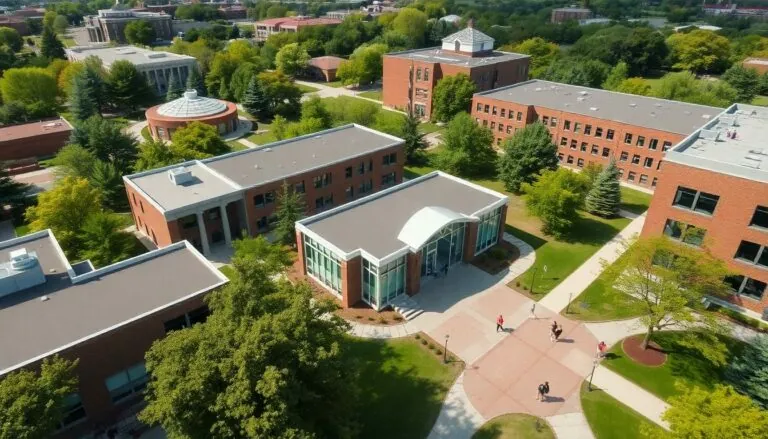Table of Contents
ToggleNavigating the world of college tuition can feel like trying to solve a Rubik’s Cube blindfolded. For those considering Champlain College, the financial puzzle might seem daunting, but fear not! This vibrant institution in Burlington, Vermont, offers more than just a degree; it’s an investment in a future filled with opportunities.
With a mix of cutting-edge programs and a community that feels like family, Champlain College promises a lot more than just a hefty price tag. Understanding the tuition structure can help students and parents make informed decisions, ensuring they get the most bang for their buck. So, let’s dive into the details and unravel the mysteries of Champlain College tuition—because who said learning about finances couldn’t be fun?
Overview of Champlain College Tuition
Champlain College offers a transparent tuition structure that helps students and families understand the costs. For the 2023-2024 academic year, undergraduate tuition stands at approximately $57,560 annually. Fees for various services add another $1,040, bringing the total estimated cost of attendance to about $61,850.
Considering living expenses, students should budget an additional $10,000 to $15,000 for housing and meals. The college provides options for on-campus housing, enhancing the student experience and convenience. Financial aid plays a significant role, with about 97% of incoming students receiving assistance in the form of grants, scholarships, or loans.
Scholarships are available based on academic achievements and other criteria. Additionally, the Champlain College Promise offers significant support to Vermont residents, providing an opportunity for reduced tuition costs. Students pursuing graduate programs should note that tuition varies; for example, the tuition for master’s programs generally ranges from $27,000 to $35,000 per year, depending on the specific program.
In-state and out-of-state students pay the same undergraduate tuition, simplifying the financial planning process. Students considering part-time enrollment can explore pro-rated tuition rates, which adjust according to the number of credits taken each semester. Understanding these nuances in the tuition structure allows families to plan effectively, making the investment in education at Champlain College clearer and more manageable.
Tuition Costs for Undergraduate Programs
Champlain College’s undergraduate tuition for the 2023-2024 academic year is approximately $57,560. This figure includes tuition and applicable fees, offering clarity for financial planning.
Breakdown of Tuition Rates
Tuition remains consistent for both in-state and out-of-state students, simplifying cost comparisons. Each credit hour for part-time students incurs a charge of around $2,240. Typically, students enroll in 15 credits per semester, translating to an annual cost of approximately $42,960 during a standard academic year. Full-time students can expect to pay the specified annual tuition rate, while part-time students may find pro-rated rates beneficial.
Additional Fees and Expenses
An extra fee of $1,040 adds to the standard tuition costs, relevant to all undergraduate students. Living expenses range between $10,000 and $15,000 annually, depending on lifestyle choices. Students residing on-campus may find housing fees and dining plans contribute significantly to overall costs. Understanding these additional expenses helps students budget effectively, making financial planning for college less daunting.
Financial Aid Opportunities
Champlain College offers various financial aid options to support students in managing tuition costs. Understanding these opportunities can significantly alleviate financial stress.
Scholarships and Grants
Various scholarships and grants are available, aimed at both merit-based and need-based assistance. Academic achievement often leads to scholarship eligibility, which can directly reduce tuition fees. Programs include the Champlain College Promise, providing affordable tuition for Vermont residents, and merit scholarships that reward outstanding performance. Furthermore, federal and state grants may complement these awards, further decreasing out-of-pocket expenses. Approximately 97% of incoming students secure financial assistance, showcasing the college’s commitment to making education accessible.
Student Loans and Work-Study Programs
Student loans play a vital role in financing education at Champlain College. Federal loans are commonly offered, allowing students to borrow funds at lower interest rates. Work-study programs present options for students to earn money while attending classes, providing valuable experience alongside financial support. These programs enable students to work on-campus jobs, thus balancing academics with employment opportunities. Combining loans with work-study can create a comprehensive financial strategy for managing educational expenses effectively.
Comparing Tuition with Other Institutions
Tuition comparisons help prospective students gauge their financial commitments. Champlain College’s tuition aligns with nearby institutions, providing context for evaluating educational investments.
Similar Colleges in the Area
Nearby colleges such as the University of Vermont and St. Michael’s College offer diverse programs with varying tuition levels. The University of Vermont charges approximately $60,600 annually, factoring in tuition and fees. St. Michael’s College sets its tuition around $55,000 per year. Both options present competitive rates, though Champlain College’s transparency about fees remains a strong advantage. Students weighing these choices can assess the overall value derived from educational experiences and support systems.
National Averages for Tuition Costs
Nationally, the average tuition for private colleges reaches about $38,000 annually, according to the National Center for Education Statistics. Champlain College’s tuition appears higher than this figure, emphasizing the specialized programs it offers. Public institutions typically range from $10,000 to $25,000 for out-of-state students. Understanding these national averages allows prospective students to better compare their potential financial commitments with those of similar institutions across the country.
Conclusion
Investing in education at Champlain College can lead to significant personal and professional growth. With a transparent tuition structure and a variety of financial aid options available, students can navigate their financial commitments more easily. The supportive community and specialized programs enhance the overall value of the college experience. By understanding the costs and available resources, prospective students can make informed decisions that align with their educational goals and financial situations. Champlain College stands out as a worthwhile choice for those seeking a quality education in a vibrant environment.







